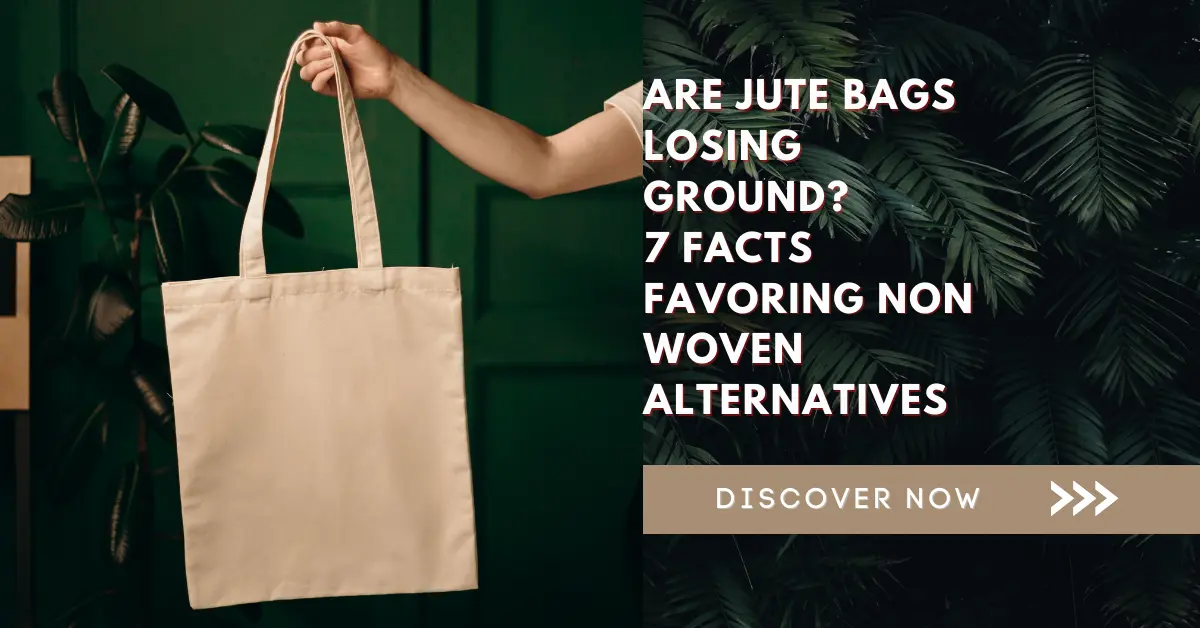
The conversation around sustainable living and eco-friendly alternatives has gained significant traction as people become more aware of their environmental impact. One such topic of discussion is the choice between jute bags, long considered a staple of eco-conscious living, and non woven alternatives, which offer a blend of durability and sustainability. Are jute bags losing ground in this battle? Let’s delve into seven compelling facts favoring non woven alternatives and why they might indeed be the future of reusable bags.
1. Durability Jute Bags
While jute bags possess a charming natural allure, their practicality sometimes falls short of expectations. Jute fibers, while biodegradable, can succumb to wear and tear over time, particularly when exposed to moisture and heavy loads. This degradation can lead to fraying, weakening the structural integrity of the bag. In contrast, non woven bags are meticulously crafted to withstand the rigors of daily life. Their synthetic composition is purposefully engineered to resist tears, spills, and abrasions, ensuring that they remain in pristine condition even after countless trips to the grocery store or gym. This durability provides consumers with peace of mind, knowing that their non woven bags will reliably serve their needs for years to come, making them a sensible and sustainable choice for everyday use.
In contrast, non woven bags are meticulously crafted to withstand the rigors of daily life. Their synthetic composition is purposefully engineered to resist tears, spills, and abrasions, ensuring that they remain in pristine condition even after countless trips to the grocery store or gym. This durability provides consumers with peace of mind, knowing that their non woven bags will reliably serve their needs for years to come, making them a sensible and sustainable choice for everyday use. Additionally, the lightweight nature of non woven materials enhances their practicality, allowing users to carry heavy loads without adding unnecessary bulk or strain. This combination of durability and convenience sets non woven bags apart as a superior alternative to traditional jute bags, meeting the evolving needs of modern consumers while minimizing environmental impact.
2. Eco-Friendliness
While jute bags have been championed as eco-friendly due to their natural fibers, the reality is more nuanced. The production process for jute involves not only the cultivation of the plant but also significant water usage and chemical treatments. Jute cultivation requires vast amounts of water, often in regions where water scarcity is already a pressing issue. Additionally, the chemical treatments involved in processing jute fibers can contribute to water pollution and soil degradation, further exacerbating environmental concerns. Moreover, the transportation of jute fibers from production sites to manufacturing facilities adds to the carbon footprint associated with jute bags.
In contrast, non woven bags offer a more sustainable alternative. Many non woven bags are made from recycled materials, such as plastic bottles or post-consumer waste, diverting these materials from landfills and reducing the need for virgin resources. The manufacturing process for non woven bags typically requires less water and energy compared to jute bag production, further lessening its environmental impact. Additionally, the versatility of non woven materials allows for the creation of bags with varying thicknesses and densities, optimizing resource usage and minimizing waste.
Furthermore, non woven bags can be recycled at the end of their lifespan, contributing to a circular economy and reducing the demand for new materials. This closed-loop system not only conserves resources but also reduces greenhouse gas emissions associated with the production of new materials. By choosing non woven bags over traditional jute options, consumers can make a tangible contribution to environmental conservation while enjoying a durable and practical reusable bag solution.
3. Innovation
Non woven bags are not only driving innovation in the reusable bag industry but also revolutionizing the way consumers approach sustainability and style. Beyond their functional benefits, non woven alternatives offer a plethora of design options and customization opportunities to suit modern lifestyles. Unlike traditional jute bags, which may have a rustic and uniform appearance, non woven options come in a wide array of shapes, sizes, colors, and configurations. This diversity allows consumers to express their individuality and personal style while making eco-conscious choices.
Furthermore, non woven bags are not limited to basic tote designs; they encompass a wide range of specialized products tailored to specific needs and activities. For instance, insulated non woven lunch carriers keep meals fresh on the go, while drawstring backpacks offer convenient storage for sports gear or beach essentials. Moreover, non woven bags can incorporate innovative features such as reinforced handles, adjustable straps, and multiple compartments, enhancing their functionality and versatility.
In addition to their aesthetic appeal and practical features, non woven bags often integrate sustainable materials and production methods, aligning with consumers’ growing eco-consciousness. By incorporating recycled materials or biodegradable components, non woven manufacturers minimize their environmental impact without compromising on quality or performance.
Overall, the versatility, customization options, and eco-friendly attributes of non woven bags make them a compelling choice for modern consumers seeking both functionality and fashion in their reusable bag solutions. As non woven technology continues to evolve and adapt to changing consumer needs, the possibilities for innovative and sustainable designs are virtually limitless, solidifying their position as the future of reusable bags.
4. High Quality
Quality is indeed paramount when it comes to reusable bags, as consumers rely on them to carry their belongings safely and securely. While jute bags may boast a natural charm, their quality can be inconsistent due to variations in fiber strength and weave integrity. Factors such as the source of the jute fibers and the craftsmanship of the bag can significantly impact its durability and longevity. In contrast, non woven bags offer a level of consistency and reliability that is unmatched in the industry.
The synthetic construction of non woven bags ensures uniformity in material composition and manufacturing processes, resulting in bags that meet stringent quality standards. Whether it’s a simple shopping tote or a specialized carry-all for outdoor adventures, non woven bags deliver consistent performance across the board. Additionally, advancements in non woven technology have led to innovations in material strength, water resistance, and durability, further enhancing their quality and reliability.
Moreover, non woven bags undergo rigorous testing and quality control measures to ensure that they meet or exceed industry standards for strength, durability, and safety. Manufacturers often subject non woven bags to stress tests, abrasion resistance tests, and environmental simulations to assess their performance under various conditions. This commitment to quality assurance gives consumers the confidence to trust non woven bags for their everyday needs, knowing that they will withstand the rigors of daily use and provide lasting value.
Furthermore, the versatility of non woven materials allows for a wide range of design options without compromising on quality. From simple, budget-friendly options to premium, high-end designs, non woven bags cater to diverse consumer preferences and budgets. Whether consumers prioritize affordability, durability, or style, there is a non woven bag available to meet their needs.
Non woven bags offer not only consistent quality but also unparalleled reliability and versatility. Their synthetic construction ensures uniformity and durability, providing consumers with a high-quality alternative to traditional jute bags. With advancements in technology and manufacturing processes, non woven bags continue to set the standard for excellence in the reusable bag industry, making them the preferred choice for discerning consumers worldwide.
5. Versatility
Non woven bags indeed offer unparalleled versatility compared to their jute counterparts, making them a preferred choice for consumers seeking adaptable and multi-functional solutions. While jute bags are traditionally associated with shopping or carrying groceries, their usefulness is often limited to these specific tasks. On the other hand, non woven alternatives boast a wide range of applications, catering to the diverse needs and lifestyles of modern consumers.
One of the key advantages of non woven bags is their ability to transition seamlessly between different activities and occasions. Whether you’re heading to the gym for a workout, lounging at the beach for a day of relaxation, or embarking on a weekend getaway, non woven bags can accommodate your needs with ease. Their lightweight construction and durable design make them ideal for carrying everything from workout gear and towels to sunscreen and snacks, ensuring that you’re prepared for whatever the day brings.
Moreover, non woven bags come in various shapes and sizes to suit different purposes and preferences. Need a spacious tote for a day of shopping or running errands? Non woven bags have you covered. Looking for a compact backpack for hands-free convenience during outdoor adventures? Non woven options abound. With features such as adjustable straps, zippered compartments, and reinforced handles, non woven bags offer practical solutions for a wide range of activities and lifestyles.
Additionally, the versatility of non woven materials extends beyond their practical functionality to include aesthetic appeal. Non woven bags come in an array of colors, patterns, and designs to suit every taste and style. Whether you prefer classic neutrals, vibrant hues, or eye-catching prints, there’s a non woven bag to complement your personal aesthetic and elevate your look.
Non woven bags stand out for their adaptability and versatility, making them a more practical choice for consumers with diverse needs and lifestyles. Whether you’re shopping for groceries, hitting the gym, or lounging at the beach, non woven bags offer the functionality, durability, and style to enhance your daily activities and simplify your life. With their ability to seamlessly transition between different tasks and occasions, non woven bags truly embody the essence of versatility in the modern world.
6. Cost-Effectiveness
While jute bags may initially appear to be a more affordable option due to their lower upfront cost, their limited durability can result in hidden expenses over time. Despite their natural appeal, jute bags are prone to wear and tear, especially with frequent use or exposure to moisture. This means that they may need to be replaced more frequently, leading to additional expenses in the long run. Moreover, the quality of jute bags can vary significantly depending on factors such as fiber strength and weave integrity, further impacting their lifespan and overall value.
In contrast, non woven bags offer excellent value for money thanks to their exceptional durability and longevity. While they may have a slightly higher initial price tag, their ability to withstand wear and tear ensures that they remain in good condition for an extended period. This means that consumers can enjoy the benefits of their non woven bags for much longer without the need for frequent replacements, ultimately saving money over time.
Additionally, the durability of non woven bags translates into reduced maintenance and replacement costs. Unlike jute bags, which may require regular cleaning or repairs to maintain their appearance and functionality, non woven bags are easy to care for and require minimal upkeep. This further contributes to their long-term cost-effectiveness and makes them a more practical investment for consumers looking to maximize value without compromising on quality.
Furthermore, the superior durability of non woven bags makes them a more sustainable choice in the long run. By minimizing the need for frequent replacements, non woven bags help reduce waste and conserve resources, aligning with principles of environmental responsibility and sustainable consumption. As consumers increasingly prioritize durability and longevity in their purchasing decisions, non woven bags emerge as a compelling option that not only offers excellent value for money but also contributes to a more sustainable future.
7. Environmental Impact
The environmental impact of reusable bags extends beyond their lifespan to include factors such as production and disposal. Jute bags, while biodegradable, require significant resources to cultivate and process, contributing to environmental degradation. Non woven bags, made from recycled materials and designed for durability, offer a more sustainable alternative. Additionally, their recyclability means that they can be repurposed at the end of their lifespan, further reducing waste and environmental impact.
Non woven bags offer a compelling alternative to traditional jute bags, providing durability, sustainability, and versatility in one package. While jute bags have long been favored for their natural appeal, their limitations in terms of durability and environmental impact are becoming increasingly apparent. By embracing non woven alternatives, consumers can enjoy the benefits of a reusable bag that not only looks good but also performs well and minimizes environmental harm. As the conversation around sustainable living continues to evolve, non woven bags are poised to become the future of reusable bags, offering a practical and eco-friendly solution for consumers around the world.


